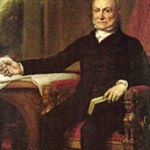During the antebellum period, the United States was torn between embracing nationalism and supporting sectionalism. Although nationalism was becoming a popular movement during the antebellum period in America, sectionalism continued to divide the county, especially the North and South. Both the ideas of Nationalism and Sectionalism were widely practiced during this period.
Examples of Nationalism include the Era of Good Feelings, Clay’s American system, and the creation and enforcement of the Monroe Doctrine. Because the Federalist party had declined and, consequently, there were fewer instances of open party feelings the United States experienced the Era of Good Feelings from 1817 to 1823; Americans wanted to relax after the turbulence of the War of 1812 and ignore party issues for the most part. The Era of Good Feelings was a national trend, found across America. The American System, an economic program designed by Henry Clay, was another example of Nationalism. Clay’s whig party, which was formed out of hatred for President Andrew Jackson, made the American System its chief platform. The American System called for a protective tariff, a national bank jointly owned by the federal government and private stockholders, and so-called “internal improvements”, which were federal subsidies for transportation projects. Rather than being given to homesteaders, public lands in the western frontier were sold in order to raise funds for educational and internal improvements. The American System promoted economic development, reduced dependence on imports, and overall united different parts of the country. President James Monroe’s message to Congress on December 2, 1813, which later became known as the Monroe Doctrine was yet another example of nationalism during the antebellum period. Initially, the Monroe Doctrine was originally drafted to call an end to European intervention in the Americas, but was later used to justify U.S. imperialism. The Monroe Doctrine was created due to two problems: a spat with Russia concerning the northwest coast of North America and the fear that the Holy Alliance would try to colonize the Latin America states that had recently gained independence from Spain. The first use of the Monroe Doctrine (which was still unnamed at that point in time) occurred in 1836 when U.S. opposed Britain’s alliance with Texas. Americans joined together under the principles of the Monroe Doctrine to prevent European powers from reclaiming the Americas. The Monroe Doctrine became an integral part of American policy and has been enforced many times throughout American history. The Monroe Doctrine, Clay’s American System, and the Era of Good Feelings.
Despite the many of instances of nationalism seen during the antebellum period, the North and South were still greatly separated. The North saw the rise of manufacturing; increased economic linkages to the West due to the Transportation Revolution; and a mass wave of German and Irish immigrants. Northern towns opened more and more factories in order to satisfy consumer demands. These factors all contributed to the emergence of a unique Northern identity by the 1830s. Improved agricultural technology, such as Eli Whitney’s cotton gin, allowed the South to produce raw materials for Northern factories faster and cheaper. The increase in raw materials called for more factories to be built, as well as the increasing population. The increasing population resulted in more consumers who would rely on Northern factories for finished goods. The South was still predominantly agricultural and looked to the North to manufacture its raw materials. Thanks to the Transportation Revolution, roads were improved, steamboats were developed, and canals and railroads were built. The fruits of the Transformation Revolution made the process of trading with the West easier and more affordable. Unfortunately for the South, a mass revolution in transit did not occur, meaning that the South depended almost entirely on the North for trade with the West. Furthermore, the South did not receive the mass wave of German and Irish immigrants that the North did during the antebellum period. While the South was still primarily inhabited by people of English, Scottish, and African descent, the North was becoming much more heterogeneous.
Meanwhile, the South saw the rise of King Cotton; opposed federal spending and tariffs; favored westward expansion and the removal of Native Americans. These factors all contributed to the emergence of a unique Southern identity by the 1830s. James Hargreaves’ invention of the spinning jenny in 1764, Richard Arkwright’s modified carding machine in 1775, and Edmund Cartwright’s invention of the power loom in 1785 transformed the cotton industry, but none of these inventions can compare to the impact that Eli Whitney’s cotton gin (patented in 1793) had upon cotton production in the South during the Antebellum period. The cotton gin quickly separated the cotton fibers used for textiles from unwanted seedpods, a tedious task that had always been done by hand in the past, usually by slaves. The machine uses a combination of a wire screen and small wire hooks to pull the cotton through the screen, while little brushes constantly remove any loose cotton that might jam the gin. By the late 1790s, demand for America’s raw cotton for the British textile industry exceeded the supply. Because the gin could remove seeds from the cotton so easily, more slaves than ever before were needed to pick cotton in order to keep up with the rate of the gin. Thanks to Eli Whitney’s invention, the quantity of cotton that could be processed in a day increased by fifty-fold, making the crop highly coveted by Southern plantation owners. The cotton gin revolutionized Southern agriculture and made the Old Southwest (Alabama and Mississippi more appealing to prospective settlers. The Old Southwest exhibited the ideal climate for cotton cultivation, with wet springs and summers, and suitably dry autumns. When cotton clothing hit the fashion scene in 1815, the British textile industry turned to the Old Southwest to satisfy its needs. Alabama and Mississippi alone were producing almost half of the nation’s cotton by 1815. By 1817, “Alabama fever” ravaged the South; settlers were so eager to prosper from the booming cotton industry that fertile land sold for as much as thirty to fifty dollars an acre—an astounding amount of money for that time. By 1836, cotton accounted for almost two-thirds of all American exports. President Andrew Jackson’s Indian Removal Act of 1830 allowed for the further expansion of “king cotton” in western Georgia, Alabama, Mississippi, and regions of Tennessee. Another factor that characterized the South was its opposition to federal spending. Southerners were against federal spending because much of the federal funding at this time was reserved for building Northern roads, railroads, and canals. In contrast, Northerners supported federal funding because it directly benefitted them. The South also opposed tariffs because they hindered individual state economies. Unlike the North, the South had an agricultural economy and depended on the North and Europe to manufacture its raw materials, which made paying tariffs a frequent economic obstacle. Southerners favored western expansion and the removal of American Indians because they were interested in acquiring more farm land. As previously mentioned, cotton was highly desirable during this period, so fertile farm land became especially desirable. Georgia, the largest state at the time, was especially eager to see the Native Americans relocated because of a jurisdictional land dispute with the Cherokees. Southerners were generally more concerned about states’ rights, farmers’ rights, tariffs, and the regulation of federal spending than North.
Despite growing nationalism, the North and the South developed two distinctly different identities. While the North was rapidly modernizing itself, the South remained almost medieval, with life revolving around the plantation much as life revolved around the manor during the Middle Ages. Northerners were more revolutionary and cosmopolitan, while Southerners clung to tradition. This divide is still evident today. The North is comprised predominantly of “Blue states” (meaning that they are on the left side of the political spectrum); they embrace social change and new technology. The South, however, is comprised predominantly of “Red states” (meaning that they are on the right side of the political spectrum); they embrace traditional and strong moral values. The fact that these differences still exist today is evidence that history repeats itself…or perhaps never changes to begin with.



